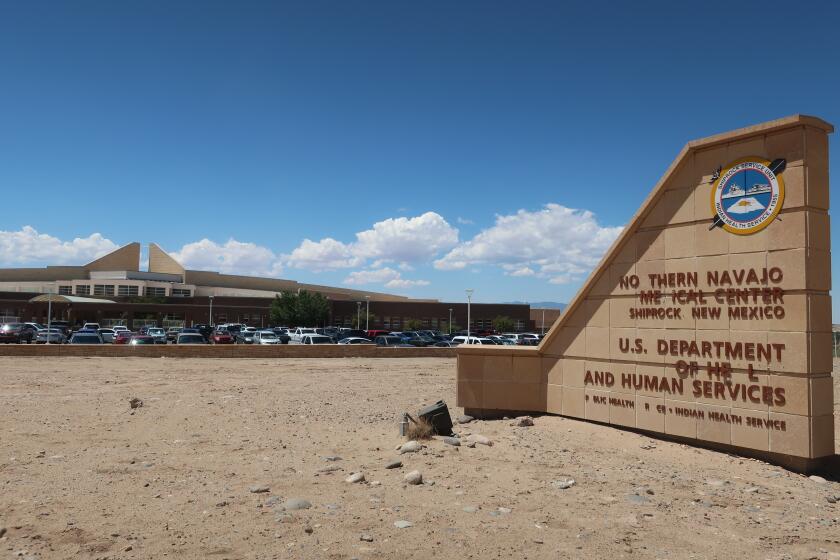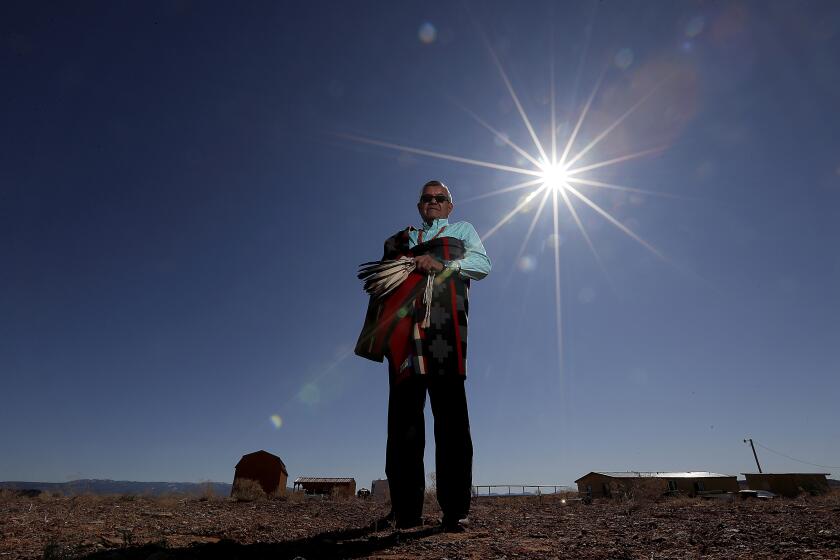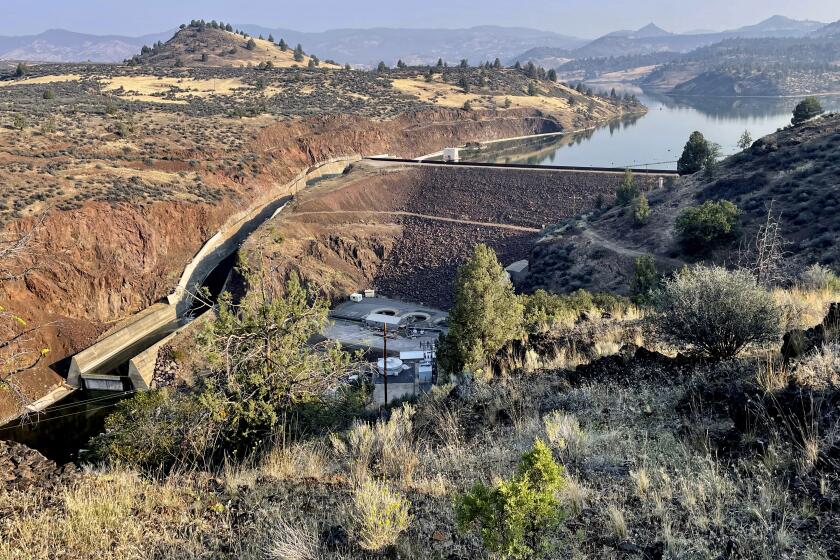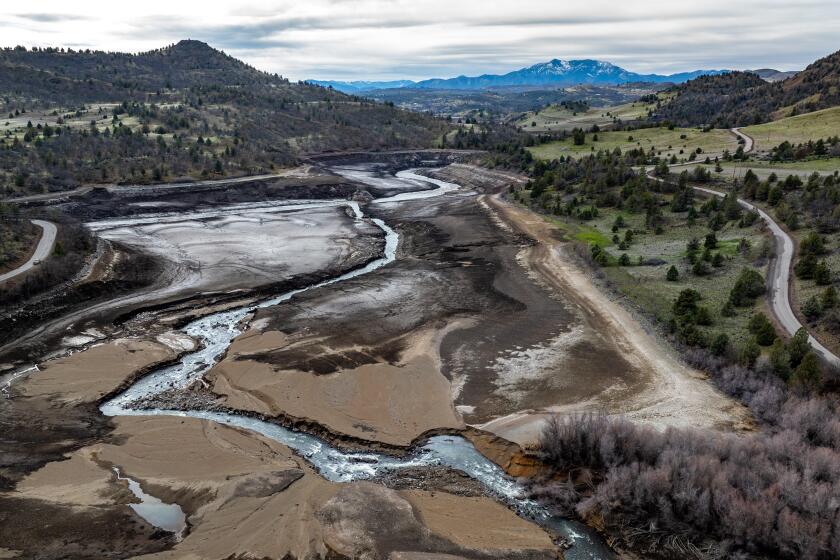A remote tribe is reeling from widespread illness and cancer. What role did the U.S. government play?

- Share via
OWYHEE, Nev. — The family placed flowers by a pair of weathered cowboy boots, as people quietly gathered for the memorial of the soft-spoken tribal chairman who mentored teens in the boxing ring and teased his grandkids on tractor rides.
Left unsaid, and what troubled Marvin Cota’s family deep down, was that his story ended like so many others on the remote Duck Valley Indian Reservation. He was healthy for decades. They found the cancer too late.
In the area, toxins are embedded in the soil and petroleum is in the groundwater, but no one can say for sure what has caused such widespread illness. Until recently, a now-razed U.S. maintenance building where fuel and herbicides were stored — and where Cota worked — was thought to be the main culprit. But the discovery of a decades-old document with a passing mention of Agent Orange chemicals suggests the government may have been more involved in contaminating the land.
“I don’t know if I’m more mad than I am hurt,” Terri Ann Cota said after her father’s service. “Because if this is the case, it took a lot of good men away from us.”
Owyhee is the sole town on the reservation, where snow-capped mountains loom over a valley of scattered homes and ranches, nearly 100 miles from any stoplights. The area is bookended by deep Nevada canyons and flat Idaho plains. For generations, the legacy and livelihoods of the Shoshone-Paiute tribes have centered on raising cattle year-round. And many still use the same medicinal plants and practice the same ceremonies as their relatives buried there did.
The U.S. government has improved funding in recent years, but American Indians still receive less care and die younger than other ethnic groups.
First spills, then potential sprays
The U.S. Bureau of Indian Affairs was an integral part of everyday life in Owyhee. The agency, which oversaw the maintenance building and irrigation shop, told the U.S. Environmental Protection Agency in February that it found a revelatory document from 1997.
In it, a bureau employee recalled clearing foliage in the irrigation canals at least 20 years earlier when he sprayed at least one of the herbicides — but possibly both — that make up Agent Orange. The EPA banned one of those chemicals in 1979 because of its cancer risks.
A bureau official told the EPA and tribal leaders that it was long believed the herbicides were used for weed control along certain roads — not the canals — before rediscovering the document.
The tribes’ current leaders said they were unaware of either scenario. What alarms them, they say, is that the canal system has greater reach than the two-lane highway that runs through town.
Word cascaded down to tribal members, most of whom live along the canals, swam in them, used the water to farm on the edges, and gathered branches from surrounding willow trees to fashion cradleboards and roast marshmallows.
But they know little else.
San Diego County’s San Luis Rey Band of Mission Indians is one of a number of tribes in the state that are still fighting for federal acknowledgment.
Hundreds of pages of emails, memos and other documents obtained by the Associated Press show federal agencies have promised the tribes that an investigation is coming. Still, the details are scarce because the Bureau of Indian Affairs redacted or withheld most of the contents of the records.
The agency declined interview requests from the AP but said it’s evaluating the extent that Agent Orange components might have been used on the reservation.
Officials from the bureau and the EPA visited Duck Valley as recently as Aug. 7 to talk about the process of hiring a contractor to clean up contamination from the federal buildings, tribal leaders said. The presentation noted gaps in data analysis, including for the storage and use of herbicides.
Action can’t come soon enough for tribal members who say the federal government’s prior cleanup attempts have lacked urgency and direction. They fear inaction could lead to further sickness and death.
While tribal Chairman Brian Mason presses federal officials for answers, tribal members are being urged to get annual medical exams and an environmental team is tasked with digging up historical documents.
“People are dying. And I don’t know what they’re waiting for,” Mason said.
A dispute over a California mega casino has divided two tribes and raised questions over U.S. government attempts to make amends for the theft of sacred lands.
Back then, tribes were unaware of the dangers
There’s a long legacy of contamination across Indian country, including uranium tailings in the Southwest, solvents dumped at a military installation in Alaska and pesticides used on the North Dakota plains. Health risks and other crucial information are often concealed from Native American communities until years, sometimes decades, after the damage is done.
At Owyhee, most of the environmental dangers have been traced to the two Bureau of Indian Affairs buildings no longer in use or demolished.
In 1985, at the now-abandoned irrigation shop, some 8,000 gallons of heating oil leaked from a pipeline next to the highway. Samples taken from sump, soil and floor drains around the building revealed a mix of the hazardous chemicals that were stored inside, including waste oil, arsenic, copper, lead and cadmium, along with the two herbicides that make up Agent Orange.
Racheal Thacker, a pesticides and solid waste technician with the tribes, said residents at the time were likely unaware of the dangers related to handling the chemicals stored there. Back then, the workers employed by the bureau didn’t have the expertise or resources to identify pollutants in the ground, Thacker said.
Sherry Crutcher was always skeptical.
Her late husband worked in the bureau’s maintenance building across from the irrigation shop and wore a uniform that reeked of chemicals after spraying willow trees and cleaning oil wells. The building was home base for dozens of tribal members who plowed snow, fought fires and maintained the vehicle fleet.
Some Native Americans are deeply offended by a movement to decriminalize peyote along with other psychedelic plants.
Crutcher, a teacher and former natural resources director for the tribes, remembers employees in the maintenance building asking for cancer screenings. She said the bureau did the tests, told the workers the results were negative but didn’t share the records.
She remembered asking her husband, Robert, whether he or the other workers had any protection. The answer was always that he had none. He died in 2022 from an aggressive form of brain cancer at age 58, she said.
“I never overstepped my husband, I just asked him the questions,” Crutcher said. “I’d be like, ‘Why?’ He was just a quiet soul, easygoing, and say, ‘Well, you know, because it’s our job.’”
In 1995, the EPA ordered the Bureau of Indian Affairs to stop discharging gasoline, batteries and other fluids onto the dirt floor of the maintenance building, saying the practice was improper, threatened the groundwater supply and could endanger tribal members’ health. The disposal practice had long-lasting effects, and the building has since been demolished with its surroundings fenced off.
In its statement to the AP, the bureau said it has extensively studied the soil and groundwater on the reservation since 1999 and cleaned up wells used for drinking water. The agency also said that any petroleum in the soil is safe and that it’s working with the tribes on other remedial actions.
Thacker said there’s no ostensible danger now from drinking water from the tap, because it’s drawn from other wells. Still, there’s an enduring sense of distrust and uneasiness.
Some patches of land can no longer sustain crops. Fences surround contaminated areas. And after tribal officials raised concerns about hydrocarbon plumes under the one school in town, the state committed to building a school on a different plot of land.
Native Americans often live far from healthcare facilities and distrust federal authorities. Still, they’re getting vaccinated against COVID-19.
Chairman’s message reverberates throughout the community
Mason stood at a lectern in March and declared — without any caveats — that the tribes’ land was further poisoned. Agent Orange chemicals were sprayed extensively by the canals, he said, and he demanded the federal government do something — and quick.
His broadcast on social media reverberated across the reservation.
The editor of the community newspaper, Alexis Smith-Estevan, listened from her couch and cried, saying she was even more certain now the federal government’s contamination of the land led to the deaths of her grandfather and uncle. A grant assistant at the health clinic, Michael Hanchor, heard about it while getting signatures for paperwork and sighed.
Hanchor wasn’t surprised. He said he saw it as yet another government failure in line with forcing his ancestors onto a reservation and sending Shoshone-Paiute children to boarding schools meant to assimilate them into white society.
“When you get that sense of defeat your whole life, you just kind of shrug your shoulders and move on,” said Hanchor, who lost his mother and a grandfather figure to cancer.
Tanya Smith Beaudoin later walked along a canal where two dirt roads converge off the highway. The canal served as a de facto swimming pool on hot summer days known to locals as “Floramae’s,” named for a sweet elder with a tough exterior who once lived next door.
Gov. Gavin Newsom has set in motion the return of ancestral lands to the Shasta Indian Nation that were seized a century ago and submerged.
Smith Beaudoin thought of her own father, Dennis Smith Sr., an influential tribal leader who befriended strangers at the market and organized big family dinners. He was diagnosed with late-stage liver cancer that spread to most of his upper body years after working alongside Cota and Robert Crutcher in the Bureau of Indian Affairs’ maintenance building, she said.
“What can you do? If you were to get infected like he was, it was a death sentence. There’s nothing — there’s no treating it,” she said.
To many in the community, there is a clear link between past contaminants and the pronounced number of cancer cases and other illnesses.
“I’m going to run out of days sooner than I should’ve,” said Julie Manning, a tribal member who was diagnosed with advanced-stage ovarian cancer last year. “And my child can pick up the pieces, and she’s been holding them together. And BIA can say, ‘Whoops, sorry.’”
The chairman’s announcement validated those beliefs. Still, health experts say it’s nearly impossible to say with certainty that the environment factored into cancer diagnoses and deaths — especially without robust data.
The tribal health clinic has logged more than 500 illnesses since 1992 that could be cancer, and is trying to break down the reservation’s data to determine the most common types. A switch in recent years from paper to electronic filing means the records are likely incomplete.
Genetics, lifestyle and other factors often combine to cause cancer. Even if the bureau is able to account for the time, frequency, concentration and volume of herbicides sprayed on the reservation, that wouldn’t be enough to prove a cause, experts say.
Ancestral lands will be returned to the Shasta Indian Nation as part of a massive Klamath River dam removal project.
“Bottom line is it’s really, really complicated even to establish among things we already sort of know about,” said Lauren Teras, the senior scientific director of epidemiology research at the American Cancer Society.
The U.S. Department of Veterans Affairs, which compensates some Vietnam War veterans for exposure to Agent Orange, presumes that certain cancers and other illnesses are caused by the chemical herbicide but doesn’t make the link definitive.
Mason has called for a study that would give tribal members a better idea of the extent chemicals could have been sprayed and the effect on the tribes’ land and its residents. He said that might provide tribal members a pathway to seek payment from the federal government.
Rooted in the land
Shoshone and Paiute tribes once separately occupied an expanse of Nevada, Idaho and Oregon before the federal government forced them onto a reservation just under the size of New York City.
They’ve lived together for generations as “Sho-Pais,” connected by a farming and ranching heritage while cheering on youth sports games and gathering for the annual Fourth of July rodeo and powwow.
High school graduates who leave often find their way home after going to college or working in trades, in a sort of coming-of-age cycle, said Lynn Manning-John, the school’s principal. Of the more than 2,000 tribal members, 1,800 or so live on the reservation — “the only place in the world where being Shoshone-Paiute is normal,” she said.
At the school, lessons are tied to being Sho-Pai. Elementary students learn “The Hokey Pokey” in the Paiute language. Some students talk to an elder in their family and bring a picture of them to hang on the classroom walls.
Army doctors, trying to stop the spread of smallpox and other contagious diseases around frontier forts in the early 19th Century, started vaccinating Indians.
“If the whole world shut down, we have everything we need to survive here,” said Manning-John, whose childhood home is now fenced off because of underground contaminants. “We have animals in the mountains, we have trees that we subsist upon for our plant medicines, we have berries, we have roots.”
“We have our beautiful water” from the mountains, she said. “But not, apparently, our water from the canal.”
Mason acknowledged an investigation into Agent Orange components will take time, even as he pushes for expediency. He was elected as chairman two years ago, marking a shift from a long line of ranchers who led the tribes to a Marine Corps veteran who most recently worked as an environmental specialist in mines across Nevada.
He likened taking the leadership post to peeling back the layers of an onion, confronting questions deeper and more personal to the tribes than before.
He grimaced when asked whether the community would move off the land if it’s eventually deemed unsafe.
“I wouldn’t say never,” he said. “But people have five, six, seven generations buried here. And they’re not going to leave their people. I can guarantee that.”
Stern writes for the Associated Press.
More to Read
Sign up for Essential California
The most important California stories and recommendations in your inbox every morning.
You may occasionally receive promotional content from the Los Angeles Times.

















